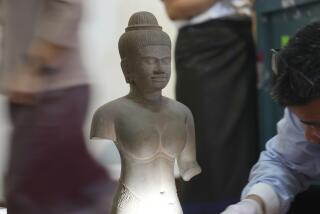Collectors Threaten Tibet’s Artistic Heritage
- Share via
Tibet’s artistic treasures are under threat from tourists and smugglers who bring them out of the country to sell to wealthy Western collectors.
During the Cultural Revolution, thousands of Tibetan artifacts and religious objects were destroyed, melted down or systematically exported to China.
Many more were saved from destruction by fervent ex-monks who worked in the fields during the day and by night buried their monastic treasures one by one in the frozen earth of the barren Tibetan mountains.
Now that these treasures, and many family heirlooms, have been dug up and returned to their original places in rebuilt monasteries and family homes, a potentially more permanent danger threatens Tibet’s cultural heritage.
Tourists strolling through the streets of the Barkhor market in Lhasa are often nervously hailed by young Tibetans who whisper “Statue? Thangka (a religious painting)?” surreptitiously gesturing that the foreigner should follow them down the alleyways of the Tibetan quarter.
At the height of the tourist influx in 1987-88, one Tibetan was openly hawking a thangka , which he claimed had been stolen from Sakya monastery. Impoverished Tibetans now sell their family treasures to eager Westerners willing to pay many times more than local traders.
The greatest danger comes from the loose network of Western, Nepalese and Tibetan traders who carry old Tibetan handicraft and artwork across the Himalayas into the hands of shopkeepers or private collectors, with the promise of large profits. Concealing a thangka in the lining of a Thermos flask is now so common that customs officers at the Nepalese border are on the lookout for this method.
Statues of Buddha are carried illegally over the Himalayan passes in the Mt. Everest region by Tibetans or Nepalese. Carpets often cross the border into Hong Kong as hand luggage. Experienced traders report that old carpets have become much harder to find in Tibet.
Officials of the Tibetan Autonomous Region’s Department of Culture, who are responsible for ensuring the preservation of Tibet’s heritage, recently denied that there was a problem of relics being smuggled out. They point to the well-established law that prohibits the export of valuable relics made before 1959, the year in which the Dalai Lama fled and Tibetan’s traditional social and political system was destroyed in what Chinese history books call the “Democratic Reforms.”
There is no working definition, however, of which pre-1959 objects are valuable. Inexperienced customs officers have been known to impound common cast iron horse stirrups while passing over priceless t hangkas .
More to Read
Sign up for Essential California
The most important California stories and recommendations in your inbox every morning.
You may occasionally receive promotional content from the Los Angeles Times.













